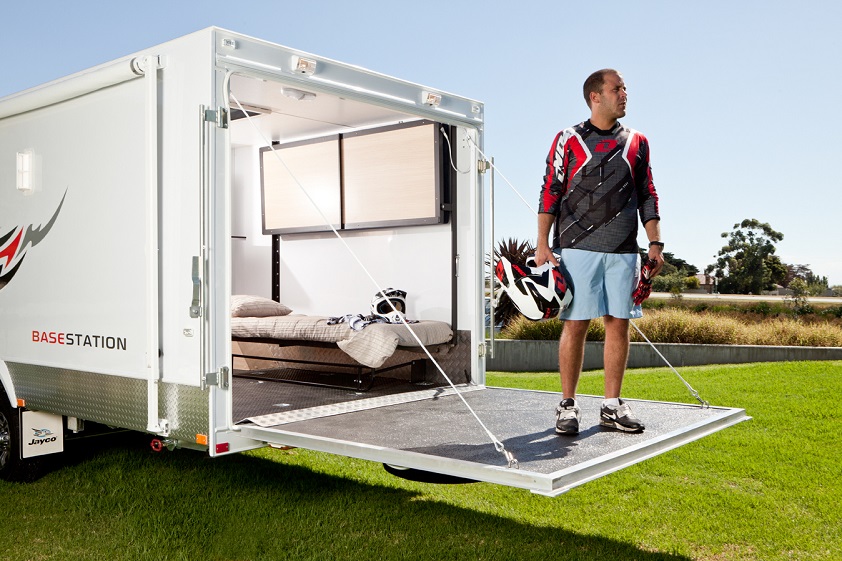It is the bane of every caravanner’s life: un-level sites. You pull up only to realise that the ground tapers off to the side, leaving you with no choice but to find a way to level the caravan.
Other than reasons of comfort, it’s important that a caravan is level if you have an absorption fridge – it probably won’t work otherwise.
Why? Absorption fridges convert their refrigerant into gas (and back again into a liquid) through heat, with the gas moving through a network of tubes. If the van isn’t level, neither is the fridge, and the refrigerant will collect in certain areas and stymie the cooling process.
Additionally, levelling the van properly will more evenly distribute the weight, preventing excessive loads in one part of the van. It will also allow the plumbing to work more effectively, the shower to drain properly, prevent things inside from rolling away, and make setting up privacy screens, etc., much easier.

LEVELLING THE CARAVAN
To level your van on uneven ground, there are a few things you can do. Levelling it north-south (along the length of the van) is relatively easy – in most cases, it’s just a matter of winding the jockey wheel up or down.
Things become a little more difficult when it comes time to level the van east-west (along the width of the van). If one wheel is higher or lower than the other, it will become necessary to compensate for the height difference.

The first point to make: use good judgement. If you can’t level your van with the appropriate equipment, don’t try to improvise – you’ll only endanger your van, yourself or other people.
Commonly, vanners will carry an off-cut of a sleeper or some other piece of timber in their van’s front boot, and this can indeed assist in raising the lower side of the van – simply back the van up, with the lower tyre coming to rest on the timber.
However, this method really doesn’t allow for incremental alterations to the level of the van. Caravan levelling ramps are the best bet, as they provide numerous ‘steps’, giving you a few height options. Further, they are inexpensive – so there’s really no excuse not to carry a set.
Before unhitching, get out of the tow vehicle and use a spirit level to determine which side is higher. Every van is different so it’s difficult to recommend the best place to test for level. Some people use a spirit level on their A-frame, while others will use one on the floor inside. Checking for level on the cabinetry may not be a great idea, depending on the workmanship. A cheap tee level mounted permanently to the A-frame, however, will provide a quick indication as to the level.

Place the levelling ramp (using two ramps for a tandem-axle van, one for each wheel) on the side that needs to be raised, and drive the van onto the ramp(s). Check the east-west level as you go up each step.
Once you’ve determined the best position for the wheel, it’s just a matter of fitting the ‘chock’, which will lock to the ramp and prevent the caravan from rolling off. However, be sure that the wheel(s) on the other side of the van are also chocked and that the handbrake is on before removing the safety chains.
Once the van is level east-west, you can then use the jockey wheel to level it north-south.
There are plenty of levelling ramps available, each of slightly different design; however, the basic principle is the same: they raise a wheel in order to level the van.
Unless you’re camped on your own private property, never dig out a section of the ground to lower a wheel – that’s just bad form, especially if you’re camped in a national or state park.
If you have to park your van on a slope, try to position it sideways, across the slope, instead of up and down the slope. This will help to prevent the van from rolling.

AIR BAGS
Air bag suspension is widely available for caravans, though it’s usually only found on offroaders. That said, a good air bag suspension setup will allow you to level your van east-west very easily. At the push of a button, you’ll be able to inflate or deflate one air bag, thereby raising or lowering one side of the van and levelling it out in the process.
If you intend on doing a lot of free-camping, where you’ll frequently encounter uneven sites, having air bags fitted, either at the time of construction of your van, or as an aftermarket item, might be worth considering.

FINAL ADVICE
Be very mindful about the potential for your van to roll off the levelling ramps. Always use chocks and never rely on the van’s handbrake alone.
Finally, remember: the corner stabilisers are for stabilising the van only – although they are often referred to as ‘jacks’, they should not be used to jack up the van. You will only damage them or something else if you wind too much pressure onto them.
MEET THE AUTHOR

Max Taylor
Max Taylor has been caravanning since he was a kid and was the editor of some of Australia’s most well-known RV publications for almost 10 years.





